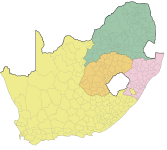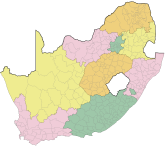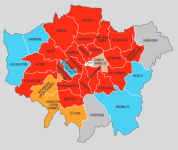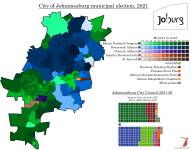U.S. House 1912 (Socialist voteshare map)
- Location
- Das Böse ist immer und überall
- Pronouns
- he/him
The Progressives weren't the only ones trying to break the two-party system from the left in 1912. In 1901, a convention of left-wing activists from numerous different groups met in Indianapolis and founded the Socialist Party of America, a broad-tent socialist movement that was intended to be the US parallel to organisations like the SPD in Germany or the Labour Party in the UK. Like them, it encompassed a broad range of opinion, from the "Sewer Socialists" of Milwaukee who largely fought for improved public services (hence the name) and didn't differ too much from the Progressives in matters of policy, through Christian prairie radicals like Julius Wayland and Oscar Ameringer, to out-and-out Marxists like Eugene Debs and the other organisers of the International Workers of the World. The party would, in fact, spend most of its existence riven with internal strife over issues like how (and to some extent whether) to oppose racial segregation, whether to focus on electoral politics or syndicalist union organising as a path to power, and most famously, whether to oppose the US joining World War I.
The fact that the SPA, unlike most mainstream socialist movements in Europe, would come out in full force against the war, and suffer a large amount of state repression as a result, has its explanation in the party's support base. One of its key demographics were immigrant labourers in the mid-sized cities of the North, many of whom had German or Austro-Hungarian origins and were none too keen to see their new homeland go to war against their old one. On the map below, we can see how many of their biggest strongholds - Schenectady, Dayton, Terre Haute, Duluth, Oakland - fit this mould, which incidentally looks a lot like the Labour base at the same time. The only major cities where the Socialists achieved any kind of strength were Chicago and Pittsburgh, which were both also extremely multicultural working-class cities at this time. Milwaukee, the most notable Socialist stronghold, fell somewhere in between the two, being a very large city but also having a solid German-speaking population bloc that would form the main base of Sewer Socialism for the next several decades.
The other Socialist base, which arguably looks more impressive at least on this map, were miners and subsistence-level farmers in the West, many of whom lived on the edge of starvation and were treated horribly by their employers (or produce buyers and landlords, in the case of small farmers), and so found a natural attraction to the idea of changing the economic structure of society. Perhaps surprisingly to modern observers, the single strongest state for the SPA in much of the 1910s was Oklahoma. The reason for this traces back to the Land Runs of 1889-95, where Congress revoked tribal titles to the land that had been Indian Territory, causing a flood of white settlers from neighbouring regions who were eager to claim a piece of the American frontier before it closed for good. Because of the lack of preparedness of many of these settlers and the specific conditions of their arrival, a large majority found themselves either destitute or one bad harvest away from destitution, and this made the then-territory fertile ground for Populist, and later Socialist, organising. Many of the settlers found a temporary solution to their desperate situation in selling their land claims to railroads or other big businesses and leasing it back, which only ended up sending them further into poverty and further into radicalisation. The Socialist Party of Oklahoma, at its peak, commanded the support of some 20% of the electorate, but suffered a particularly brutal crackdown after 1917 and never really returned to prominence.
As far as I know, 1912 was the best Socialist performance in any US federal election, in spite of the fact that they won no seats. Eugene Debs, who was nominated as the SPA's candidate for President on a cross-faction unity ticket with Sewer Socialist Emil Seidel, won just shy of 6% of the popular vote, but the party's congressional candidates actually outdid him by some margin, winning 7.9% of the vote across 335 candidates - one of the largest slates put up by a third party in the 20th century, and more than half again as many as the Progressives. Then again, this broad slate of candidates may have hurt the party as much as it helped, because again, none of them got elected. This illustrates pretty clearly the difference between Progressive and Socialist paths to power - one was a top-down movement of reformist politicians and concerned high-profile citizens, with a large amount of name recognition for their leading figure(s) and a severe lack of ground game, while the other was a bottom-up movement of trade unionists and agitators who gathered a large organising base but was only able to break through in the few places where they obtained prominence.
The SPA would only ever send two representatives to Congress, though never more than one at a time, and as mentioned, neither won their seat in the party's best election. Victor Berger, one of the leading Sewer Socialists, had won election to Congress from the north side of Milwaukee (WI-5) in 1910, but was defeated in his bid for re-election by Republican candidate W. H. Stafford - the two would alternate in the seat until 1933. The other Socialist congressman was Meyer London, who won his seat on the Lower East Side of Manhattan (NY-12) in 1914 and served three non-consecutive terms ending in 1923, but his time had still not come in 1912 as the Democratic incumbent held the seat.
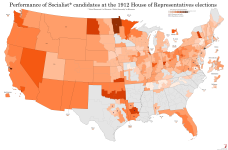
The fact that the SPA, unlike most mainstream socialist movements in Europe, would come out in full force against the war, and suffer a large amount of state repression as a result, has its explanation in the party's support base. One of its key demographics were immigrant labourers in the mid-sized cities of the North, many of whom had German or Austro-Hungarian origins and were none too keen to see their new homeland go to war against their old one. On the map below, we can see how many of their biggest strongholds - Schenectady, Dayton, Terre Haute, Duluth, Oakland - fit this mould, which incidentally looks a lot like the Labour base at the same time. The only major cities where the Socialists achieved any kind of strength were Chicago and Pittsburgh, which were both also extremely multicultural working-class cities at this time. Milwaukee, the most notable Socialist stronghold, fell somewhere in between the two, being a very large city but also having a solid German-speaking population bloc that would form the main base of Sewer Socialism for the next several decades.
The other Socialist base, which arguably looks more impressive at least on this map, were miners and subsistence-level farmers in the West, many of whom lived on the edge of starvation and were treated horribly by their employers (or produce buyers and landlords, in the case of small farmers), and so found a natural attraction to the idea of changing the economic structure of society. Perhaps surprisingly to modern observers, the single strongest state for the SPA in much of the 1910s was Oklahoma. The reason for this traces back to the Land Runs of 1889-95, where Congress revoked tribal titles to the land that had been Indian Territory, causing a flood of white settlers from neighbouring regions who were eager to claim a piece of the American frontier before it closed for good. Because of the lack of preparedness of many of these settlers and the specific conditions of their arrival, a large majority found themselves either destitute or one bad harvest away from destitution, and this made the then-territory fertile ground for Populist, and later Socialist, organising. Many of the settlers found a temporary solution to their desperate situation in selling their land claims to railroads or other big businesses and leasing it back, which only ended up sending them further into poverty and further into radicalisation. The Socialist Party of Oklahoma, at its peak, commanded the support of some 20% of the electorate, but suffered a particularly brutal crackdown after 1917 and never really returned to prominence.
As far as I know, 1912 was the best Socialist performance in any US federal election, in spite of the fact that they won no seats. Eugene Debs, who was nominated as the SPA's candidate for President on a cross-faction unity ticket with Sewer Socialist Emil Seidel, won just shy of 6% of the popular vote, but the party's congressional candidates actually outdid him by some margin, winning 7.9% of the vote across 335 candidates - one of the largest slates put up by a third party in the 20th century, and more than half again as many as the Progressives. Then again, this broad slate of candidates may have hurt the party as much as it helped, because again, none of them got elected. This illustrates pretty clearly the difference between Progressive and Socialist paths to power - one was a top-down movement of reformist politicians and concerned high-profile citizens, with a large amount of name recognition for their leading figure(s) and a severe lack of ground game, while the other was a bottom-up movement of trade unionists and agitators who gathered a large organising base but was only able to break through in the few places where they obtained prominence.
The SPA would only ever send two representatives to Congress, though never more than one at a time, and as mentioned, neither won their seat in the party's best election. Victor Berger, one of the leading Sewer Socialists, had won election to Congress from the north side of Milwaukee (WI-5) in 1910, but was defeated in his bid for re-election by Republican candidate W. H. Stafford - the two would alternate in the seat until 1933. The other Socialist congressman was Meyer London, who won his seat on the Lower East Side of Manhattan (NY-12) in 1914 and served three non-consecutive terms ending in 1923, but his time had still not come in 1912 as the Democratic incumbent held the seat.



